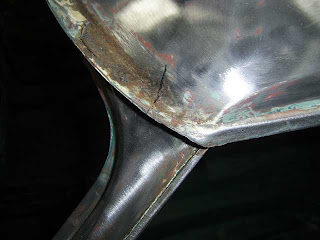Between taking the Bank holiday weekend off to play engines at the Cambridge Museum of Technology and preparation for the external audit, I have been able to get a bit more done on the GT6. Both the front and rear screens are now in, making it almost waterproof. In the end I decided to have my (relatively new) clear windscreen moved over from the old body and fitted in the new body, as none of the windscreen fitters I contacted could supply the tinted glass.
The wiring loom was carefully removed from the old body an transferred over with minimal fuss, which meant I could also fit the dash and steering column.
The loom has been altered again slightly to tidy it up and to allow the EDIS unit for the megajolt ignition system to stay within the car, behind the passenger glove box.
Getting brave, I decided to confirm the position of the header tank and coil pack on the bulkhead, drilling into the fresh paint. Extra length fasteners will be used here, so the EDIS unit and megajolt unit can be mounted on a plate underneath. Now I've fixed the position of the coil pack I can measure-up the length of the plug leads and consider getting a set of Magnecore ordered.
I had to move the car out of the workshop for a couple of day, so it gave me a good chance to get a shot of the rear, with the refurbed lights and new number plate. It really does look quite funny to me with the skinny tyres and the rear wheels hiding far within those arches.
In other news, the BMW E21 has passed it's MOT again first time, with only a couple of advisories, which I shall see to in the next week or so.
















































